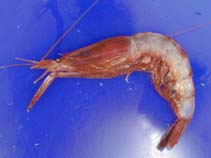Pasiphaea multidentata Esmark, 1866
Pink glass shrimp
Classification / Names Populärnamn | synonymer | CoL | ITIS | WoRMS
Malacostraca | Decapoda | Pasiphaeidae
Environment: milieu / climate zone / djupintervall / distribution range Ekologi
Batypelagisk; djupintervall 10 - 2000 m (Ref. 8126), usually 400 - 400 m. Subtropical; 76°N - 16°N, 75°W - 37°E
Distribution Länder | FAO områden | Ekosystem | Förekomster | Utplanteringar
Arctic, Atlantic Ocean and the Mediterranean: from Boothia Peninsula, Canada to Mauritania, east to the Mediterranean.
Length at first maturity / Size / Weight / Age
Könsmognad: Lm ? range ? - ? cm Max length : 10.5 cm TL hane/ej könsbestämd; (Ref. 8136); 4.54 cm CL (female)
Life cycle and mating behavior Könsmognad | Reproduktion | Lek | Eggs | Fecundity | Larvae
Main reference
referenser | Koordinator | Medarbetare
Hayashi, K.-I. 2006 Revision of the Pasiphaea alcocki species group (Crustacea, Decapoda, Pasiphaeidae). p. 193-241. In B. Richer de Forges and J.-L. Justine (eds) Tropical deep-sea benthos. Mémoires du Muséum national d'Histoire naturelle 24(193). (Ref. 8126)
IUCN Red List Status
(Ref. 130435: Version 2025-1)
CITES status (Ref. 108899)
CMS (Ref. 116361)
Threat to humans
Human uses
Fiskeri: kommersiell
| FishSource |
Verktyg
Ytterligare information
Max. ages / sizes
Length-weight rel.
Length-length rel.
Length-frequencies
Mass conversion
Abundans
Internet-källor
BHL | BOLD Systems | CISTI | DiscoverLife | FAO(Publication : search) | Fishipedia | GenBank (genome, nucleotide) | GloBI | Gomexsi | Google Books | Google Scholar | Google | PubMed | Tree of Life | Wikipedia (Go, sök) | Zoological Record



